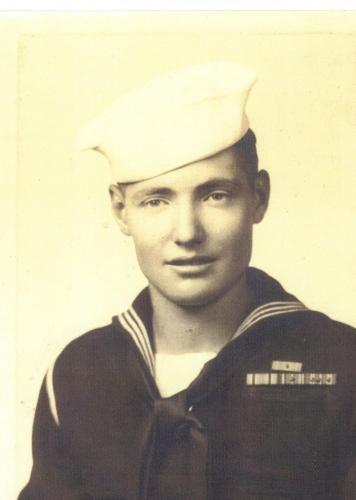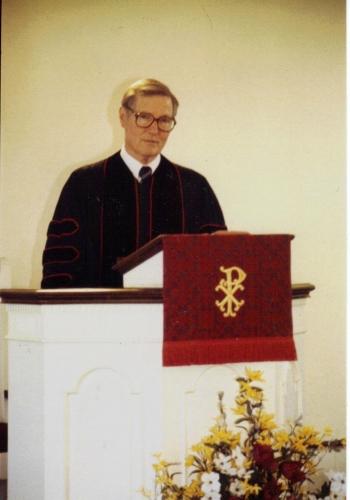Veteran Richard O. Young
Richard O. Young
Richard O. “Dick” Young was born May 30, 1922 near Le Compte, Louisiana to Benjamin Walter and Alice Austin Young. He was the fifth child in a family of eight children. After living on several different farms, his father was able to purchase a farm when Richard was ten years old. At an early age he and his brother were bitten by a rabid dog and had to undergo the painful treatment for rabies. He attended a one room school with a pot-bellied stove that served both as a school and a church. Richard was introduced to work early in life; at age five he was assigned the responsibility of finding the cow (found by the sound of her bell) each evening and bringing her home to be milked. As he became older, he picked cotton on neighboring farms and learned the rigors of hard work. Childhood memories reflect life in the Deep South in an isolated community. He first tasted Jello in his grandmother’s kitchen, saw his first airplane which he thought looked like a flying box car, and tasted ice tea for the first time when he visited an uncle at a CCC (Civilian Conservation Corp) camp. While the family had little discretionary money, they worked hard and had a strong sense of independence.
Richard attended Forest Hill High School and graduated in 1939. He was then confronted with the issue of preparing for his future. He had made good grades in high school and was given a scholarship to Louisiana State University, but the amount was insufficient to cover the cost for tuition. Through a cousin he learned about the opportunities provided by the CCC. He therefore joined the CCC and after six months in Louisiana, he was sent to Nevada to fight forest fires and to perform other duties. He returned home and enlisted in the Navy in August of 1940. He traveled to boot camp in San Diego, California where he was introduced to the basics of Navy life. Although he had been promised leave after boot camp, it was not granted and he was sent to Hawaii and assigned to a destroyer, the USS Worden at Pearl Harbor. During the next year Richard grew in his knowledge of Navy life, spent some time in a Navy hospital in San Diego with pneumonia, and was joined aboard the Worden at Pearl Harbor by his younger brother, Herbert.

About the fateful morning of December 7, 1941 Richard wrote in his diary after the attack:
Dec. 7, 1941
It was early on Sunday morning and everyone was lounging around reading papers or asleep. We began to notice explosions and saw planes diving. They looked unfamiliar and when we looked across the harbor, we saw large columns of smoke rising. At first we thought it was practice, but when we saw the USS Utah get hit, we manned our guns immediately.
….A squadron tried to bomb us, but we drove them away with anti-aircraft fire. One bomb hit 50 feet off our fantail and one of our gunners brought down a plane. After an hour of steady firing the Worden got underway. As we left the harbor we saw the Utah sinking, the Arizona burning all over, the West Virginia afire and sinking, the Tennessee inboard of her on fire, the California sinking and the Oklahoma capsized. Near the net of the harbor we saw the Nevada beached and sitting low in the water. It had been bombed.
It is hard to express the deep sadness that overcame the members of our crew as we steamed out of the harbor. We were extremely proud of the Navy, and our hearts would have been heavy if only one of our great ships had been sunk. But to see all of them either sunk or sinking, and our entire fleet virtually decimated, was almost more than we could bear. It was not that we were afraid, or even that we thought that the Japanese could beat us; it was the loss of the ships and the men that tore us up.
Thus, WWII had begun and Richard was to continue to be involved in combat for several more years. Many times in the Pacific his destroyer was called upon to drop depth charges when its sonar devices detected a submarine, and in at least two instances the submarines showed evidence of being hit. He was in the battle at Midway and witnessed the Yorktown being sunk. His ship was escorting the Saratoga at the battle of Guadalcanal when it was hit by torpedoes. In 1943 he was transferred to the USS Laub, another destroyer, and on this ship he passed through the Panama Canal to the Atlantic. His new ship crossed the Atlantic several times escorting large merchant vessels with war supplies. During the invasion of Sicily the Laub supported the Allied landing by bombarding inland targets.
After Sicily he came back to the U. S. and applied for welding school. While in welding school he learned of the Navy V-12 Officer Training Program which would provide four years of college in addition to officer training. Securing a college education was one of Richard’s major goals, so he applied and was accepted. He attended the V-12 program at the University of Richmond and then after one year was transferred to the Navy ROTC program at Duke University. During his second semester at Duke, Richard developed rheumatic fever. After hospitalization and extended bed rest, he was given a honorable discharge from the Navy for medical reasons in July of 1945.
After leaving the Navy, Richard explored several vocational avenues before enrolling at L. S. U. with a major in mathematics. While there he met Madge Mixon from Osyka, Mississippi. The couple was married in January of 1948 at the First Presbyterian Church in Baton Rouge, Louisiana. Richard continued his studies and earned both a bachelors degree and a masters degree. Also, he worked on a doctorate in mathematics at LSU while on a teaching fellowship, but his program was interrupted when his major professor died. He then left the program in 1952 and was employed for as an actuary in Baton Rouge and later in Houston, Texas. During these years three children, Richie, Jean, and Sally were born to the couple. Their fourth child, Greg, was born a few years later.

After his marriage, Richard became active in the Presbyterian Church and soon felt a call to enter the ministry. He enrolled at Austin Presbyterian Theological Seminary and earned the Master of Divinity Degree in 1960 and was ordained the same year. During his ministerial career he held pastorates in Texas, Arkansas, Mississippi, and Kentucky. While serving a church in Louisville, he earned the Doctor of Ministry Degree at Louisville Presbyterian Theological Seminary. Richard retired from fulltime ministry in 1987, but subsequently served as a part-time pastor in Louisiana and West Virginia.
In 1984, Richard became the National Chaplain for the Pearl Harbor Survivors Association. He and Madge were given several trips to Honolulu to take part in Associations conventions. Then in 2004 he was invited to take part with Cliff Robertson, Governor Rick Perry of Texas, and the Honorable George Herbert Walker Bush, in a commemorative ceremony in Texas that honored Pearl Harbor survivors.
Richard and Madge purchased a dwelling near Massanetta Springs in 1994 and after living there for some years they moved to the Highlands at Sunnyside Retirement Community. While living in the Harrison burg area he has continued to serve local churches as an interim and supply pastor.
As told to Bill Blair